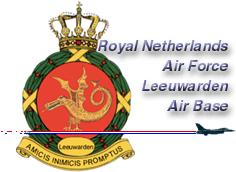Crest and motto

Base Crest
Leeuwarden Air base, situated in what can be referred to as the heart of the province of Friesland, has a base crest that originates from the same province: a gold colored flying dragon on a red background.
History
In the chronicles of Ockam Scharlensem of 1597, the appearance of a dragon is mentioned. A rough translation of some of the essential parts follows.
Midsummer during spring, on the southwest of Red Cliff "mountain", about ten steps from there, a flame arose which burned for three days in a row. On the fourth day a huge dragon arose from there, being raised high in the sky terrifying many. After having showed itself for half an hour, it again descended.
This chronicle mentions a flying dragon near the Red Cliff near a location called Gaasterland — in the south-west of the province. Later, Pierium Winsemius describes the same appearance in 1662. Again, a very rough translation of some of the essential parts follows.
For the Cliff south of Stavoren, after having thrown out flames for three days, it also produced a dragon which showed itself in the sky above Stavoren, causing terror.
These mysterious fires above the Red Cliff are being mentioned several times after this, on separate occasions. First as terrifying appearances in the dark Middle Ages, and much later as a symbol of protection of the Frisian country. The Frisian town Molkwerum in Gaasterland was protected from thundershowers coming from the Zyuder Zee (nowadays called IJsselmeer). It is said that the town was safeguarded against these showers — fires from the sky — by the dragon.
Because the flying dragon as mentioned in these chronicles is related to the airspace surrounding us and also because of its function as a safeguard against evil to the population, this symbol was chosen for the base crest of Leeuwarden Air Base. Still, flying "dragons" are out there in the sky surrounding us, offering protection to the citizens.
The related device ANIMICIS, INIMICIS, PROMPTUS, meaning Ready for Enemy and Friend (Voor Vriend en Vijand Paraat), only emphasizes this.